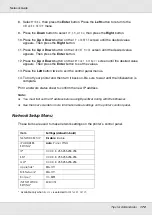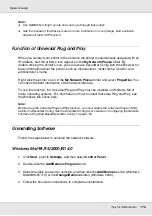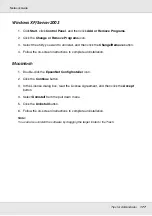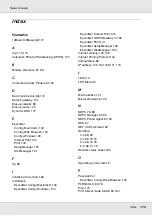
Tips for Administrator
173
Network Guide
Setting an IP Address Using the arp/ping Command
If you are using UNIX or OS/2, you need to use the arp and ping command to set the IP
address of the network interface. You can also use these commands with Windows
Me/98/XP/2000/NT 4.0, if you have correctly installed TCP/IP networking on these
systems.
Note:
❏
Make sure that the
Set using PING
function is enabled on the TCP/IP menu in EpsonNet
Config. If this function is disabled, you cannot set the IP address using the arp/ping command.
❏
Make sure the network interface and the computer are in the same segment.
Before you start, you need the following information:
❏
A valid IP address for the network interface. Ask your network administrator for an IP
address which does not cause conflicts with any other device on the network. If you are
the network administrator, choose an address within your subnet which does not
conflict with any other device.
❏
The MAC (Ethernet hardware) address of the network interface. You can find out the
MAC address on a status sheet.
Checking the LAN
First, you need to check that the computer can reach to other computer in the same
segment, as follows:
1. Set the default gateway to the host on which you are setting up the network interface.
If there is a server or a router which acts as a gateway, enter the address of the server
or the router. If there is no gateway, enter the IP address of your computer as a gateway
address.
2. Assume that you want to reach to the computer having the IP address
“192.168.100.101”. Check that the computer is reachable by “pinging” it from the
command line:
ping 192.168.100.101
3. If the computer is reachable, you can see the following result (the exact form of the
message depends on your operating system, and the time may vary):
64 bytes from 192:168:100:101:icmp_seq=0. Time=34.ms








































